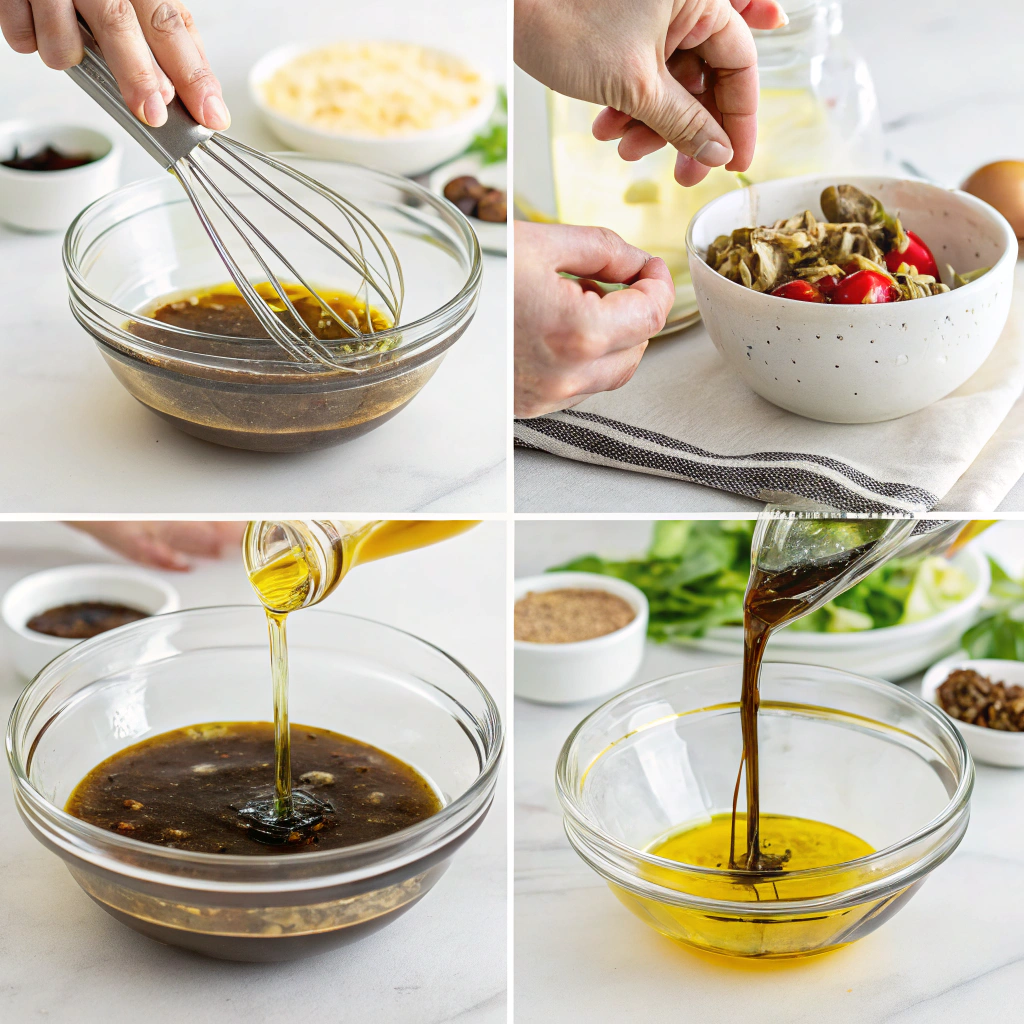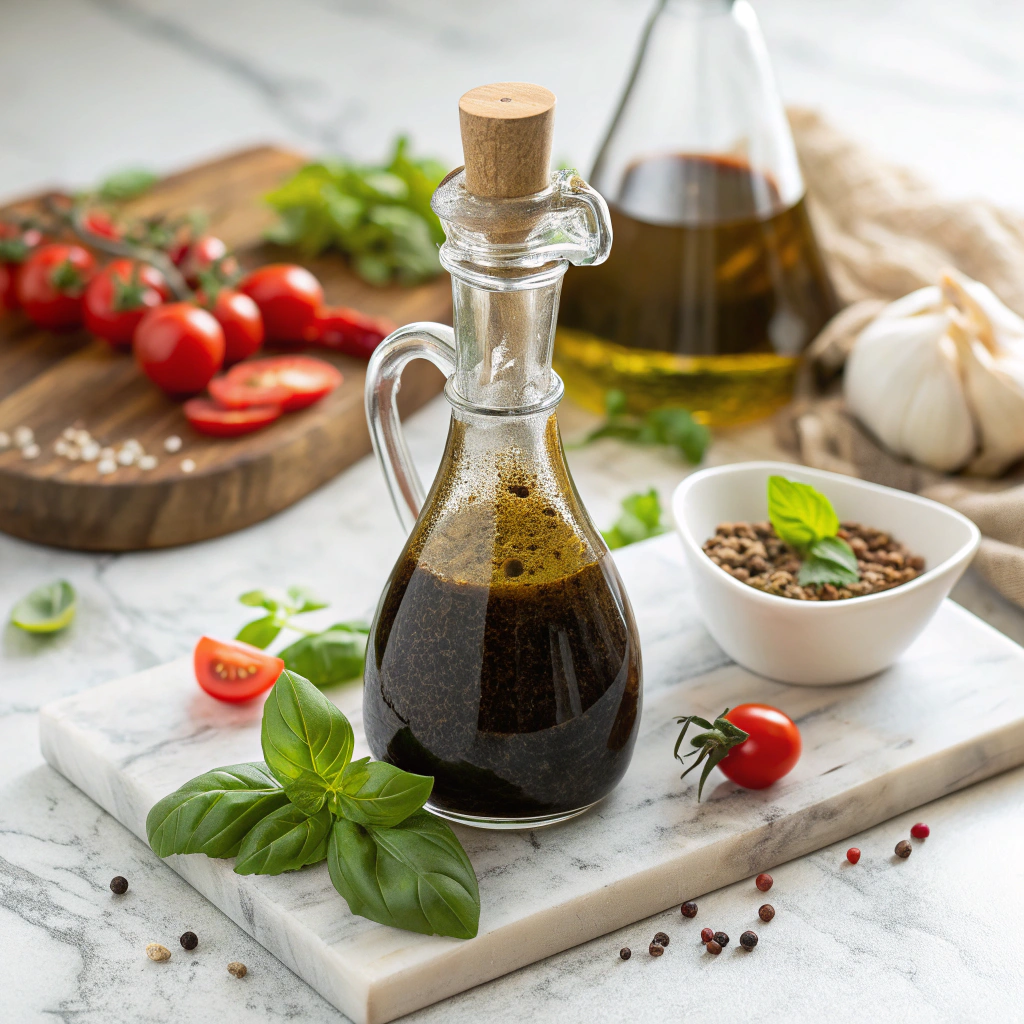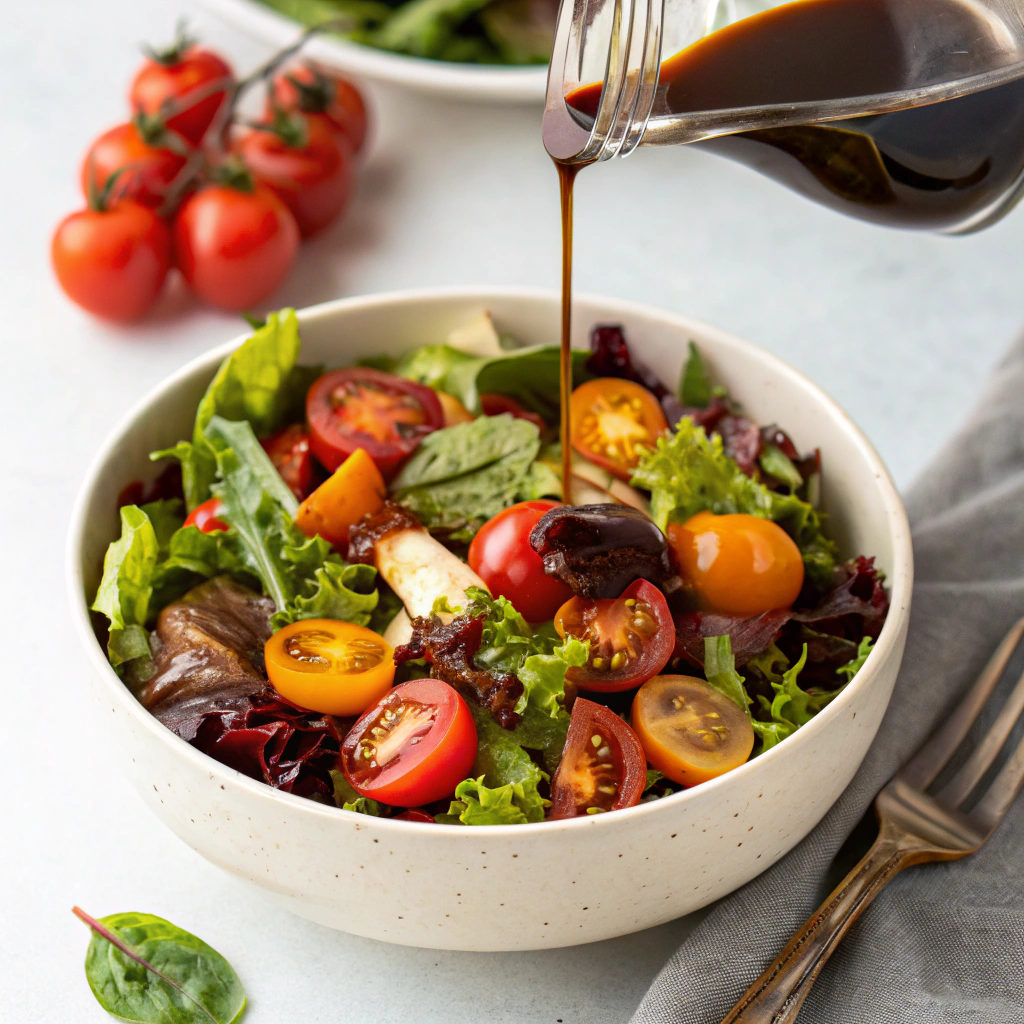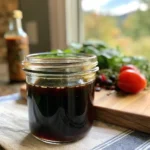Transform ordinary salads into gourmet experiences with the perfect balsamic vinaigrette dressing that rivals expensive restaurant versions. Nothing elevates fresh greens and vegetables quite like a well-crafted balsamic vinaigrette dressing made from premium ingredients in your own kitchen. While store-bought dressings contain preservatives, artificial flavors, and lack the fresh, balanced flavor profile that makes meals memorable, creating your own homemade version puts you in complete control of every ingredient. This comprehensive guide will teach you to master the art of creating restaurant-quality balsamic vinaigrette dressing using simple ingredients and professional techniques that ensure perfect emulsification every time.
Table of Contents
| Essential Recipe |
| Ingredients (Makes 1 cup / 240ml): ¼ cup (60ml) high-quality balsamic vinegar ¾ cup (180ml) extra virgin olive oil 1 tablespoon Dijon mustard 1 clove garlic, minced finely 1 teaspoon honey or maple syrup ½ teaspoon salt ¼ teaspoon freshly ground black pepper 2 tablespoons fresh herbs (basil, oregano, or thyme) Equipment: Medium mixing bowl Wire whisk Measuring cups and spoons Glass storage jar with tight lid |
| Step-by-Step Method |
| Step 1: Prepare the Base (2 minutes): Combine dry ingredients in medium bowl: Balsamic vinegar Minced garlic Dijon mustard Honey Salt and pepper Whisk thoroughly until honey dissolves completely |
| Step 2: Create Perfect Emulsion (3-5 minutes): Start slowly: Drizzle olive oil drop by drop while whisking continuously Maintain constant motion: Use steady, circular whisking pattern Gradually increase oil flow as emulsion forms Continue whisking for 2-3 minutes until thick and creamy |
| Step 3: Finish and Rest (10-15 minutes): Add fresh herbs and fold in gently Taste and adjust seasonings Let rest 10-15 minutes for flavors to meld Whisk again before serving |
Essential Balsamic Vinaigrette Dressing Recipe
Creating the perfect balsamic vinaigrette dressing starts with understanding the fundamental ratios and techniques that professional chefs use. The classic foundation combines high-quality balsamic vinegar with extra virgin olive oil in a 1:3 ratio, though this can be adjusted based on personal preference and the acidity level of your chosen vinegar.
Perfect Ingredient Ratios
For a standard batch of homemade balsamic vinaigrette dressing, you’ll need:
1/4 cup (60ml) high-quality balsamic vinegar – 3/4 cup (180ml) extra virgin olive oil – 1 tablespoon Dijon mustard – 1 clove garlic, minced finely – 1 teaspoon honey or maple syrup – 1/2 teaspoon salt – 1/4 teaspoon freshly ground black pepper – 2 tablespoons fresh herbs (basil, oregano, or thyme)

Step-by-Step Preparation Method
The key to exceptional balsamic vinaigrette recipe lies in proper emulsification technique. Begin by whisking the balsamic vinegar, minced garlic, Dijon mustard, honey, salt, and pepper in a medium bowl until well combined. The mustard acts as an emulsifier, helping to bind the oil and vinegar together for a smooth, cohesive dressing.
Slowly drizzle the olive oil into the vinegar mixture while whisking continuously in a steady, circular motion. This gradual incorporation is crucial for achieving proper emulsification. If you add the oil too quickly, the vinaigrette will separate and appear broken. The mixture should gradually thicken and develop a creamy, unified appearance.
Emulsification Techniques
Professional chefs employ several methods to ensure their homemade balsamic dressing maintains perfect consistency. For those seeking more detailed guidance, this detailed main content approach ensures success every time. The traditional whisk method works well for small batches, while a blender or food processor creates more stable emulsions for larger quantities. When using mechanical methods, start with the vinegar mixture and slowly add oil through the feed tube while the machine runs.
Temperature plays a crucial role in emulsification success. All ingredients should be at room temperature before combining, as cold ingredients resist proper blending. If your olive oil has been refrigerated, allow it to warm naturally before use.
Health Benefits of Balsamic Vinaigrette Dressing
Understanding the nutritional advantages of healthy balsamic vinaigrette reveals why this dressing choice supports overall wellness goals. Unlike commercial dressings loaded with preservatives and artificial ingredients, homemade versions provide substantial health benefits through their simple, natural components.
Nutritional Profile Analysis
A typical two-tablespoon serving of homemade balsamic vinaigrette dressing contains approximately 120 calories, with most calories derived from heart-healthy monounsaturated fats found in extra virgin olive oil. The dressing provides minimal carbohydrates and no cholesterol, making it suitable for various dietary approaches including Mediterranean and low-carb eating plans.
Balsamic vinegar contributes antioxidants, particularly polyphenols, which help combat oxidative stress in the body. These compounds have been studied for their potential anti-inflammatory properties and cardiovascular benefits. Research from authoritative article on the subject demonstrates the positive impacts of regular olive oil consumption on heart health markers.
Heart-Healthy Properties
The extra virgin olive oil in balsamic vinegar benefits provides oleic acid, a monounsaturated fat associated with reduced inflammation and beneficial effects on genes linked to cancer prevention. Studies suggest that regular consumption of high-quality olive oil may help lower blood pressure and reduce the risk of cardiovascular disease.
Digestive Benefits
Balsamic vinegar’s acetic acid content supports digestive health by potentially improving insulin sensitivity and helping to regulate blood sugar levels after meals. The vinegar may also promote the growth of beneficial gut bacteria, contributing to overall digestive wellness.
Ingredient Quality Guide for Best Balsamic Vinaigrette
Selecting premium ingredients elevates your best balsamic vinegar dressing from ordinary to extraordinary. Understanding quality indicators helps you make informed purchasing decisions that directly impact flavor and nutritional value.
Choosing Premium Balsamic Vinegar
Authentic balsamic vinegar originates from specific regions in Italy, particularly Modena and Reggio Emilia. Traditional balsamic vinegar, aged for minimum 12 years, offers complex sweetness and depth that commercial varieties cannot match. For everyday quality vinaigrette ingredients, look for “Aceto Balsamico di Modena IGP” certification, which guarantees authentic production methods and quality standards.
Avoid balsamic vinegars containing caramel coloring or artificial thickeners. Quality indicators include dark, syrupy consistency, complex aroma, and ingredient lists containing only grape must and vinegar. Price often reflects quality, with genuine aged balsamic commanding higher costs due to extensive production time and traditional methods.
Extra Virgin Olive Oil Selection
The foundation of exceptional olive oil types lies in proper extraction and storage methods. Seek cold-pressed, extra virgin olive oil with harvest dates within the past 18 months. Quality oils display robust flavor profiles ranging from peppery and bold to mild and buttery, depending on olive variety and growing conditions.
Store olive oil in dark glass bottles away from heat and light to preserve delicate flavor compounds. Single-origin oils often provide more consistent flavor profiles than blends, allowing you to customize your vinaigrette’s character based on the oil’s inherent properties.
Fresh vs. Dried Herbs
Fresh herbs contribute vibrant flavors and aromatic compounds that dried versions cannot replicate. Basil, oregano, thyme, and rosemary pair exceptionally well with balsamic vinaigrette, each offering distinct flavor profiles. When fresh herbs aren’t available, use high-quality dried herbs at one-third the amount specified for fresh varieties.
Balsamic Vinaigrette Variations and Flavors
Exploring creative balsamic vinaigrette variations allows you to customize flavors for different cuisines and dietary preferences. Professional insights from trusted insights and research show how simple modifications can transform basic recipes into gourmet creations.
Herb-Infused Variations
Mediterranean-inspired flavored vinaigrette incorporates fresh basil, oregano, and sun-dried tomatoes for robust Italian flavors. French herb variations feature tarragon, chives, and parsley, creating elegant dressings perfect for delicate greens. For Middle Eastern influences, add fresh mint, cilantro, and a pinch of sumac for tangy brightness.
Sweet and Savory Adaptations
Honey-sweetened versions balance acidity while adding floral notes, particularly effective with strong greens like arugula or kale. Maple syrup alternatives provide earthier sweetness ideal for autumn salads featuring roasted vegetables or nuts. Savory adaptations might include roasted garlic, caramelized shallots, or even nutritional yeast for umami depth.
Dietary Restriction Modifications
Creating custom dressing recipes for specific dietary needs requires thoughtful substitutions. For low-sodium diets, reduce salt content and enhance flavor with additional herbs, garlic, or citrus zest. Sugar-free versions rely on natural sweetness from high-quality balsamic vinegar without added sweeteners. Vegan adaptations replace honey with agave nectar or pure maple syrup while maintaining similar flavor profiles.
Storage and Shelf Life of Homemade Balsamic Vinaigrette
Proper storing balsamic vinaigrette techniques ensure optimal flavor retention and food safety. Unlike commercial dressings with artificial preservatives, homemade versions require specific storage considerations to maintain quality and prevent spoilage.
Proper Storage Methods
Store finished vinaigrette shelf life in clean glass containers with tight-fitting lids. Glass jars prevent flavor absorption and allow easy monitoring of the dressing’s condition. Refrigerate immediately after preparation, maintaining temperatures below 40°F (4°C) for food safety compliance.
Separation is natural in homemade vinaigrettes due to the absence of commercial emulsifiers. Simply shake or whisk vigorously before each use to re-incorporate ingredients. If separation occurs rapidly or the dressing appears broken despite proper technique, the emulsification may need improvement during the next preparation.
Shelf Life Guidelines
Properly stored homemade balsamic vinaigrette dressing maintains peak quality for 7-10 days when refrigerated. The high acidity from vinegar provides some preservation benefits, but fresh ingredients like garlic and herbs limit overall shelf life compared to commercial alternatives.
Food Safety Considerations
Monitor stored dressing for signs of spoilage including off odors, mold growth, or unusual color changes. Fresh garlic poses the highest risk for bacterial growth, particularly botulism in oil-based preparations. Food safety protocols recommend using freshly minced garlic and consuming the dressing within one week to minimize risks.

Creative Uses for Balsamic Vinaigrette Dressing
Versatile balsamic vinaigrette uses extend far beyond traditional salad applications. Understanding these alternative uses maximizes the value of your homemade preparation while expanding culinary creativity.
Beyond Salads: Alternative Applications
Transform roasted vegetables by drizzling vinaigrette marinade over hot preparations, allowing flavors to penetrate while vegetables remain warm. Grilled vegetables benefit from balsamic vinaigrette both as a pre-cooking marinade and finishing sauce. Root vegetables like carrots, beets, and sweet potatoes develop caramelized edges when tossed with vinaigrette before roasting.
Marinade and Sauce Applications
Chicken and fish marinades benefit from balsamic vinaigrette’s acidic components, which help tenderize proteins while infusing flavor. Marinating times vary from 30 minutes for delicate fish to 4 hours for chicken pieces. The natural sugars in balsamic vinegar promote beautiful caramelization during grilling or roasting.
Vegetable kebabs marinated in balsamic vinaigrette develop complex flavors perfect for halal-compliant grilling options. Bell peppers, zucchini, mushrooms, and cherry tomatoes absorb the dressing’s flavors while maintaining their natural textures.
Pairing with Different Cuisines
Mediterranean cuisine naturally complements balsamic vinaigrette’s Italian origins. Use as a finishing sauce for grilled halloumi cheese or drizzle over fresh mozzarella and tomato preparations. Middle Eastern applications include dressing for fattoush salads or as a flavor enhancer for roasted eggplant dishes.
Contemporary salad dressing ideas incorporate balsamic vinaigrette into grain bowls featuring quinoa, farro, or bulgur wheat. The dressing’s acidity brightens heavy grains while its richness satisfies hunger effectively.
Frequently Asked Questions
How long does homemade balsamic vinaigrette dressing last?
Properly stored homemade balsamic vinaigrette dressing maintains optimal quality for 7-10 days when refrigerated in a sealed glass container. The high acidity from vinegar provides natural preservation, but fresh ingredients like garlic limit shelf life. Signs of spoilage include off odors, unusual color changes, or mold growth. For best flavor and safety, consume within one week and always store below 40°F (4°C).
Can I make balsamic vinaigrette dressing without olive oil?
Yes, you can substitute olive oil with other neutral-flavored oils like avocado oil, sunflower oil, or grapeseed oil. Each alternative affects flavor differently – avocado oil provides similar richness with milder taste, while lighter oils create more vinegar-forward dressings. For lower-fat versions, replace half the oil with vegetable broth or water, though this reduces the traditional creamy texture of balsamic vinaigrette dressing.
What’s the best ratio for balsamic vinaigrette dressing?
The classic balsamic vinaigrette dressing ratio follows 1 part vinegar to 3 parts oil (1:3), though personal preferences and vinegar acidity levels allow for customization. For tangier dressings, try 1:2.5 ratios, while milder preferences work well with 1:4 ratios. Start with the traditional 1:3 proportion and adjust according to taste, considering that high-quality aged balsamic vinegars often require less oil due to their natural sweetness and complex flavors.
Is balsamic vinaigrette dressing healthy for weight loss?
Homemade balsamic vinaigrette dressing can support weight management when used in appropriate portions. A typical 2-tablespoon serving contains about 120 calories, primarily from heart-healthy monounsaturated fats. The vinegar component may help with satiety and blood sugar regulation. For weight loss, focus on portion control and use the dressing to make nutrient-dense vegetables more appealing, encouraging higher vegetable consumption.
How do I fix separated balsamic vinaigrette dressing?
Separation in balsamic vinaigrette dressing is natural and easily corrected. For quick fixes, shake vigorously in a sealed jar or whisk rapidly by hand. For better long-term emulsification, start fresh by whisking vinegar and mustard together, then slowly add the separated mixture while whisking continuously. Adding a small amount of Dijon mustard or honey helps stabilize the emulsion and prevent future separation.
Can balsamic vinaigrette dressing be made ahead of time?
Balsamic vinaigrette dressing actually improves when made ahead, allowing flavors to meld and develop complexity. Prepare up to one week in advance and store refrigerated in glass containers. The dressing reaches peak flavor after 24-48 hours. Make large batches for meal prep convenience, portioning into smaller containers for daily use. Always bring to room temperature and mix well before serving for optimal texture and flavor distribution.

Mastering homemade balsamic vinaigrette dressing elevates any meal from ordinary to extraordinary, providing you with complete control over ingredients and flavors. The techniques and insights shared in this comprehensive guide ensure consistent results that rival expensive restaurant versions while supporting your health and dietary goals. Quality ingredients make a significant difference in achieving that perfect balance of tangy sweetness that makes balsamic vinaigrette the most versatile dressing option. Proper storage ensures lasting freshness and safety, allowing you to enjoy your creation throughout the week while maintaining peak flavor profiles. We encourage you to try this recipe and experiment with the suggested variations, adapting flavors to match your personal preferences and dietary needs. Share your results and creative adaptations – the best balsamic vinaigrette dressing recipes often come from home cooks who aren’t afraid to experiment with premium ingredients and time-tested techniques.
Print
Best Balsamic Vinaigrette Dressing Recipe & Health Benefits
- Total Time: 25 minutes
- Yield: 1 cup (16 servings) 1x
- Diet: Vegan
Description
Master the art of creating silky, restaurant-quality balsamic vinaigrette at home with this essential recipe. This versatile dressing combines the perfect balance of tangy balsamic vinegar, fruity olive oil, and aromatic seasonings to create a thick, creamy emulsion that elevates any salad from ordinary to extraordinary. With proper technique and quality control, you’ll achieve that coveted creamy consistency that coats greens beautifully and stays perfectly mixed.
Ingredients
- ¼ cup (60ml) high-quality balsamic vinegar
- ¾ cup (180ml) extra virgin olive oil
- 1 tablespoon Dijon mustard
- 1 clove garlic, minced finely
- 1 teaspoon honey or maple syrup
- ½ teaspoon salt
- ¼ teaspoon freshly ground black pepper
- 2 tablespoons fresh herbs (basil, oregano, or thyme)
Instructions
- Prepare the Base (2 minutes): In a medium bowl, combine balsamic vinegar, minced garlic, Dijon mustard, honey, salt, and pepper. Whisk thoroughly until honey dissolves completely and mixture is uniform.
- Create Perfect Emulsion (3-5 minutes): Start slowly by drizzling olive oil drop by drop while whisking continuously. Maintain constant motion using a steady, circular whisking pattern. Gradually increase oil flow as emulsion forms, continuing to whisk for 2-3 minutes until thick and creamy.
- Finish and Rest (10-15 minutes): Add fresh herbs and fold in gently. Taste and adjust seasonings as needed. Let rest 10-15 minutes for flavors to meld, then whisk again before serving.
Notes
Pro Tips for Success: Temperature matters – use room temperature ingredients for better emulsification. If ingredients are cold, let them sit out for 15-20 minutes. Emulsification Technique: Add oil very slowly at first (drop by drop) and maintain constant whisking motion. If separation occurs, start over with a small amount in a clean bowl. Quality Indicators: A good emulsion should be thick, creamy, and stay mixed for several minutes. A poor emulsion will be thin, separate immediately, and have an oily surface. Storage: Refrigerate in airtight container for up to 2 weeks. Bring to room temperature and whisk before using.
- Prep Time: 10 minutes
- Cook Time: 0 minutes
- Category: Condiment
- Method: No-Cook
- Cuisine: Mediterranean
Nutrition
- Serving Size: 1 tablespoon (1/16th of recipe)
- Calories: 95
- Sugar: 1g
- Sodium: 45mg
- Fat: 10g
- Saturated Fat: 1.5g
- Unsaturated Fat: 8g
- Trans Fat: 0g
- Carbohydrates: 1g
- Fiber: 0g
- Protein: 0g
- Cholesterol: 0mg

